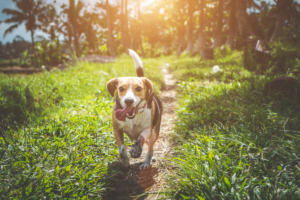How To Reduce Excessive Shedding in Dogs

Every dog sheds its hair on a daily basis. Even dogs who are not prone to shedding will do so at some point throughout the year due to environmental factors. This is completely normal and should not be cause for concern. There are, however, times when shedding can become excessive or is the result of another condition. In these moments, it is advisable to find ways to reduce dog shedding or see a vet if the problem persists.
The natural loss of old or damaged hair is a part of life and allows a dog’s coat to remain healthy. The amount and frequency of hair loss can depend on a variety of elements in a dog’s life. Different breeds of dogs lose different amounts of hair. The seasons can affect hair loss. Age also has an effect on shedding. But a dog’s coat is a good indicator of their internal health. This is why it is vital to keep track of hair loss and to take action when shedding gets out of control.
Causes of Shedding
There are many reasons that dogs molt their hair. These include diet, lifestyle, seasonal conditions, and underlying health issues. It can be difficult to identify what the motive is behind excessive shedding in your dog. It is important to know what everyday issues could be causing this effect to rule out other more serious conditions. Take a look at these common causes of excess shedding to be aware of what steps you need to take.
Factors that can make dogs shed more include increased stress, poor nutrition, and certain existing medical conditions or treatments. Other elements to bear in mind include allergies or sensitivities to certain foods or environmental factors such as pollen or common parasites.
Finally, if all external components of your dog’s life seem to be normal, it may be time to visit the vet to request expert help. They may need to run tests to see if there is an underlying disorder causing excessive shedding.
Protect Against Canine Hair Loss and Minimize Shedding
Shedding is completely natural in all dog breeds, as it is with humans. But there are ways to reduce shedding and help keep a well-groomed and healthy dog.
Nutrition
Firstly, it is paramount to a dog’s health to ensure a well-balanced diet with all the right nutrients. Getting the best vitamins and minerals into your furry friend’s nutrition means their body will naturally develop a shiny, thick coat of hair. Cheap dog foods are not worth it. They may save you some pennies to begin with, but your dog’s health will suffer for it. Quality dog foods include a good list of ingredients rich in meat, fish, and easily digested vegetables. They are comprised of the correct proteins which help healthy hair growth. Some human foods such as apples and lean meats are ideal for a balanced canine diet. There are also certain foods that should be completely avoided in your dog’s diet.
In addition to the premium dog food you choose, certain oils can be a great benefit to your dog’s diet. Rich in omega-3 fatty acids which help to decrease dandruff and calm inflammations of the skin, these oils help to reduce itching and irritation.
Another vital step in ensuring a healthy pup is providing access to clean, fresh water at all times. Your dog must stay hydrated to help their skin retain moisture and reduce any dry skin that can lead to shedding.
Grooming
To help maintain a healthy coat, it is important to brush your dog’s hair regularly. This will get rid of any excess fur and remove built-up dirt on the skin. There are different types of combs and brushes which work best on distinct types of hair. Ask your local vet or pet store for help finding one that suits your breed’s hair.
Additionally, you should ensure to have the right cosmetic products such as shampoos for your dog’s hair. It is advisable to find a dermatologically approved shampoo that can aid in alleviating itching. The bathing routine is also important to consider. Over-bathing can be a problem for dogs and cause their skin to dry out, which will increase shedding. Research the right schedule for bathing your breed.
There are also specific de-shedding tools that can be used for dogs who are prone to heavy shedding. These are best used at certain times of the year when seasons are changing.
Finally, it is critical that you use regular, effective treatments against fleas and their eggs. Controlling flea problems will drastically improve molting in your dog by preventing skin irritations and subsequent scratching.
Find out as much as you can about your dog’s breed to be well-informed of skin and hair conditions that could affect shedding. When in doubt, consult your local vet for expert help.
About the Author iPetCompanion Team
Related Posts
Melatonin as a known supplementary treatment for Cushing’s disease in dogs
4 Tips For Choosing The Best Canada Pooch Toy
The Benefits of Nutritional Supplements for Pets
5 Best Tips for Training Your Service Dog
What Is a Heated Dog Bed?
Top Mistakes that People Make When Getting a Dog

